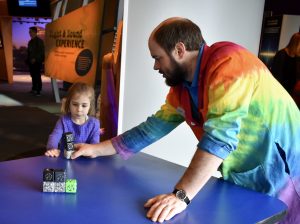Materials to Collect
- Smooth surface
- Large container ½ full of water
- Tray
- Marker cap
- Tablecloth with no seamed edge
- Egg
Try it!
Tablecloth Trick:
- Set up your tablecloth under your large container of water on a smooth surface. You want a couple of inches of tablecloth to extend past the container on one side.
- Hold the other side of the tablecloth firmly, making sure that you don’t create any wrinkles or ripples in the tablecloth on the far side of the container.
- Pull the tablecloth smoothly and quickly towards you. Make sure to not pull the tablecloth up or to one side as you pull it out.

Egg Drop:
- Set up your large container of water on a table. Rest your tray on top of the container and then balance your marker cap in the middle of the tray with the egg on top of the cap.
- VERY QUICKLY push the tray firmly off of the container. Make sure to push the tray so it flies off the container straight and doesn’t tip to one side.

NOTE: Try these tricks in a place that you don’t mind potentially getting wet. This is a great project to try outside!
What is the Science?
If you try either of these demos slowly, you might notice that they don’t work the same as when you try them quickly. The container will be dragged along by the tablecloth, and the egg will travel with the tray. This is because of friction. It is possible to overcome this friction by moving the tablecloth or the tray quickly and firmly.
The other reason why your container and egg don’t move when these tricks are done quickly is inertia. Objects that are at rest tend to stay at rest until they are acted upon by an outside force. When you pull the tablecloth or hit the tray quickly, the force of the tray and the tablecloth doesn’t act on the container or the egg as much. The container and the egg stay still, and in the egg’s case – drop down because of gravity.
Ask Your Young Scientists
- What happens when we pull the tablecloth slowly? What happens when we pull it fast?
- What do you notice when we use light objects vs. heavy objects on our tablecloth?
- Can you pull the tray instead of hitting it and get the same results? Why or why not?
- Does the shape of our object matter? Do tall, skinny objects act the same as short, heavy objects?
More to Explore
Try the tablecloth trick with as many objects as you can think of. Try objects of different weights and ones that are top-heavy compared to ones with low centers of gravity. You can also try this on different surfaces. Can you figure out why we recommend a smooth surface?
Inertia is all around you. Next time you are in the car, notice how your body reacts when the car slows or speeds up. Think about how your body would react if there were no seatbelt exerting a force on you.
We want to see what you try at home. Share your creation with us by tagging @CTScienceCenter and using the #ScienceAtPlay on social media for a chance to be featured.


Andrew Fotta is a STEM educator at the Connecticut Science Center. He has currently holds a CT teaching certification for grades K-6, and has spent time in the classroom in nearly all grades, and taught middle school science. In addition to teaching classes for the Science Center, Andrew is also part of a team of educators currently creating new programs aligned with the new Next Generation Science Standards for grades PreK-9. Andrew is an avid photographer, who enjoys blending science and art in his work.

